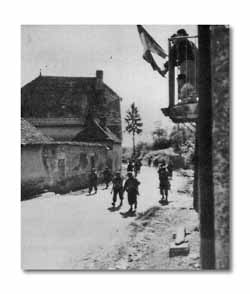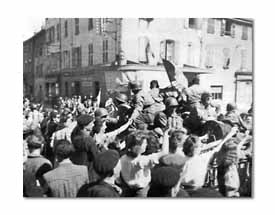| The Wehrmacht hurried to get back into Germany
through the Belfort Gap. To keep the pace our-motorized advances netted 25 to 40 miles
each day. Convoys, sometimes 13 miles long, raced along often a whole day without making
contact. Leading columns lanced out deep to the front, using back-roads and trails off the
main highways to avoid enemy blocking devices and mines. Spearheads moved boldly, yet with
a certain caution, knowing that hostile forces might be waiting at any turn, or stalking
in ambush. As each mile was gained, it added further burden upon supply, still being
serviced hundreds of miles from the beaches by day-and-night shuttle transport. Our snaking columns lined up: reconnaissance elements
probing ahead; infantry riding tanks and tank destroyers, alert to deploy at the sign of
trouble; more infantry riding 2 ½-ton trucks; artillery trucks and weapons following,
overloaded with infantry again. The Division had only 60 per cent of its organic vehicles;
with all vehicles present an Infantry Division has an insufficient number to carry all of
its men. But by overloading every vehicle the Division motorized itself. Thus an entire
combat team moved quickly, yet was organized and able to meet any serious opposition.
|
|

| In Bourg, above Lyons, it was the same story -- a wildly
enthusiastic crowd greeting their liberators. |

|